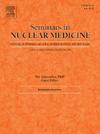新的有希望的感染成像靶点。
IF 5.9
2区 医学
Q1 RADIOLOGY, NUCLEAR MEDICINE & MEDICAL IMAGING
引用次数: 0
摘要
感染的诊断是至关重要的住院病人生存,预防长期住院和不当的发病率和死亡率。这可以使用针对特定微生物或宿主免疫反应成分的各种工具来实现。最有用的工具将是通过能够区分无菌炎症和本身引起炎症的感染来诊断特定致病微生物的工具。这使得适当和有效的抗菌素治疗得以及时建立,有效地减少了抗菌素耐药性的发生率。目前的标准护理诊断工具,如炎症标志物、培养、形态成像和分子成像工具有特定的缺点,需要其他工具来补充。感染成像的各种目标已经被探索,并在临床前或临床设置中展示了不同的效用。本文将讨论细菌、真菌和病毒中的相关靶点,并探讨有前途的或新的分子成像工具。本文章由计算机程序翻译,如有差异,请以英文原文为准。
New Promising Targets for Imaging in Infection
The diagnosis of infection is crucial in-patient survival, prevention of prolonged hospitalization and undue morbidity and mortality. This can be achieved using various tools target at the specific microbes or the host immune response components. The most useful tool will be one that diagnoses the specific causative microbe by being able to distinguish sterile inflammation from infection which by itself causes inflammation. This allows timeous institution of the appropriate and effective antimicrobial therapy, effectively reducing the incidence of antimicrobial resistance. Current standard of care diagnostic tools such as inflammatory markers, culture, morphological imaging and molecular imaging tools has specific shortcomings which necessities enlist other tools to complement them. Various targets for infection imaging have been explored and demonstrated variable utilities in the preclinical or clinical settings. This review will discuss the relevant targets in bacteria, fungi and viruses and delve into the promising or novel molecular imaging tools.
求助全文
通过发布文献求助,成功后即可免费获取论文全文。
去求助
来源期刊

Seminars in nuclear medicine
医学-核医学
CiteScore
9.80
自引率
6.10%
发文量
86
审稿时长
14 days
期刊介绍:
Seminars in Nuclear Medicine is the leading review journal in nuclear medicine. Each issue brings you expert reviews and commentary on a single topic as selected by the Editors. The journal contains extensive coverage of the field of nuclear medicine, including PET, SPECT, and other molecular imaging studies, and related imaging studies. Full-color illustrations are used throughout to highlight important findings. Seminars is included in PubMed/Medline, Thomson/ISI, and other major scientific indexes.
 求助内容:
求助内容: 应助结果提醒方式:
应助结果提醒方式:


